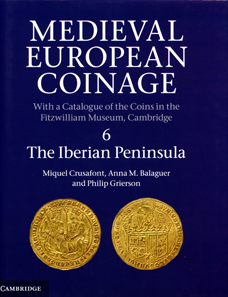by Ursula Kampmann
October 10, 2013 – My library contains books I simply like. Because they give information in a diverting way, because they have images of pleasing coins, because they are bibliophilic or for many more reasons. And then there are books of which I know that my library would be worthless without them since they are the fundament of any profound research on the subject they deal with. MEC is one of the second kind of books.
Miquel Crusafont, Anna M. Balaguer, Philip Grierson. Medieval European Coinage. Volume 6: The Iberian Peninsula. Cambridge University Press. Cambridge 2013. 929 p. 136 fig. 41 pl. 25 x 20 cm. Hard cover. ISBN 9780521260145. 150 pounds.
MEC – Medieval European Coinage – the abbreviation reminds a bit of RIC, RPC, or in short of all these monumental corpora which have scientifically catalogued the whole coinage of a certain epoch. As its name reveals the MEC is entirely dedicated to the Middle Ages hence to the epoch between c.450 and 1500 CE. Eventually, the project should consist of 20 volumes of which the third has now been published. It covers the Iberian Peninsula on 886 pages and 60 plates.
Nine chapters give all information we possess today on numismatics of medieval Spain. After a short introduction into the historical background and numismatics follows a section on money circulation in the peninsula. Then the issuing key figures are presented, the Muslim realms, the Carolingians, the Kingdom of Catalonia and Aragon, Mallorca, Navarra, Castile and Leon, and, in the end, Portugal. All chapters are organised analogously. They start with a comprehensive bibliography, then follows a list of the mints and, at the end, the coins are discussed according to smaller geographical, political or chronological sections.
It goes without saying that this is no book for a light read. At least after half an hour one’s head is spinning because of all the details meticulously put at the right place. But every one who needs to look for something cannot avoid the MEC.
Anyway, most coin dealers and museum curators will just settle for the wonderful ‘picture-book’, the plates at the end of the volume. The coins of the Iberian Peninsula in the gigantic collection of medieval coins at the Fitzwilliam Museum are listed there. And the list goes from 1 to 1131, a real paradigm of lucidity! Every single coin is photographed with a description right beside. Thanks to that even a beginner will find the kingdom, ruler and mint of his coin by looking at the images. Well, let’s be honest, you must take a very close look indeed, if you want to distinguish the many variations. However, this type corpus is a very big help for the difficult task of describing a coin!
Comprehensive concordances for the most important reference works and thorough indices conclude this book that must be part of EVERY library whose owner intends to deal seriously with medieval numismatics.
Finishing this review I must remember two men. They are responsible that this project of generations has not been given up. Philipp Grierson, who has received the well-earned honour of being mentioned seven years after his death as co-author besides the famous specialists Miquel Crusafont and Anna M. Balaguer. He had the vision of collecting European medieval coins in the post-war period when virtually no one was interested in this stuff and, hence, even a professor at Cambridge could afford those coins. Philipp Grierson donated over 20,000 objects – today worth some millions – to the Fitzwilliam Museum in 1976. Thanks to this huge collection the MEC has no problems with images for these volumes.
The preface is signed as well by a numismatist we all miss. Mark Blackburn finished the preface of this third MEC volume in July 2011. On September 1 he died aged only 58. For decades he had been the moving force, the good spirit who encouraged the researchers to continue contributing to the MEC. This volume is his monument as well.
Even though all these RICs, Sylloges and numismatic handbooks have become our natural companions in daily life we should not forget how much time and effort researchers have invested in them – often besides of the demands of their actual job. Behind every fine book there are people who have created a monument for eternity for themselves.
The book was published by the Cambridge University Press.
The MEC project is presented on the website of the Fitzwilliam Museum.
Join Ursula Kampmann and visit the Coin Cabinet of the Fitzwilliam Museum with her.





